ACC204 Advanced Financial Accounting: Depreciation, Journal Entries
VerifiedAdded on 2023/06/11
|8
|1131
|283
Homework Assignment
AI Summary
This assignment solution for ACC204 Advanced Financial Accounting includes detailed answers and calculations related to depreciation methods, journal entries, construction accounting, and impairment loss. It covers topics such as determining depreciation factors, preparing journal entries for various transactions, calculating gross profit using the percentage-of-completion method, and accounting for impairment of goodwill and other assets. The solutions provide step-by-step explanations and calculations, referencing relevant accounting standards. Desklib offers this and many other solved assignments and study resources for students.
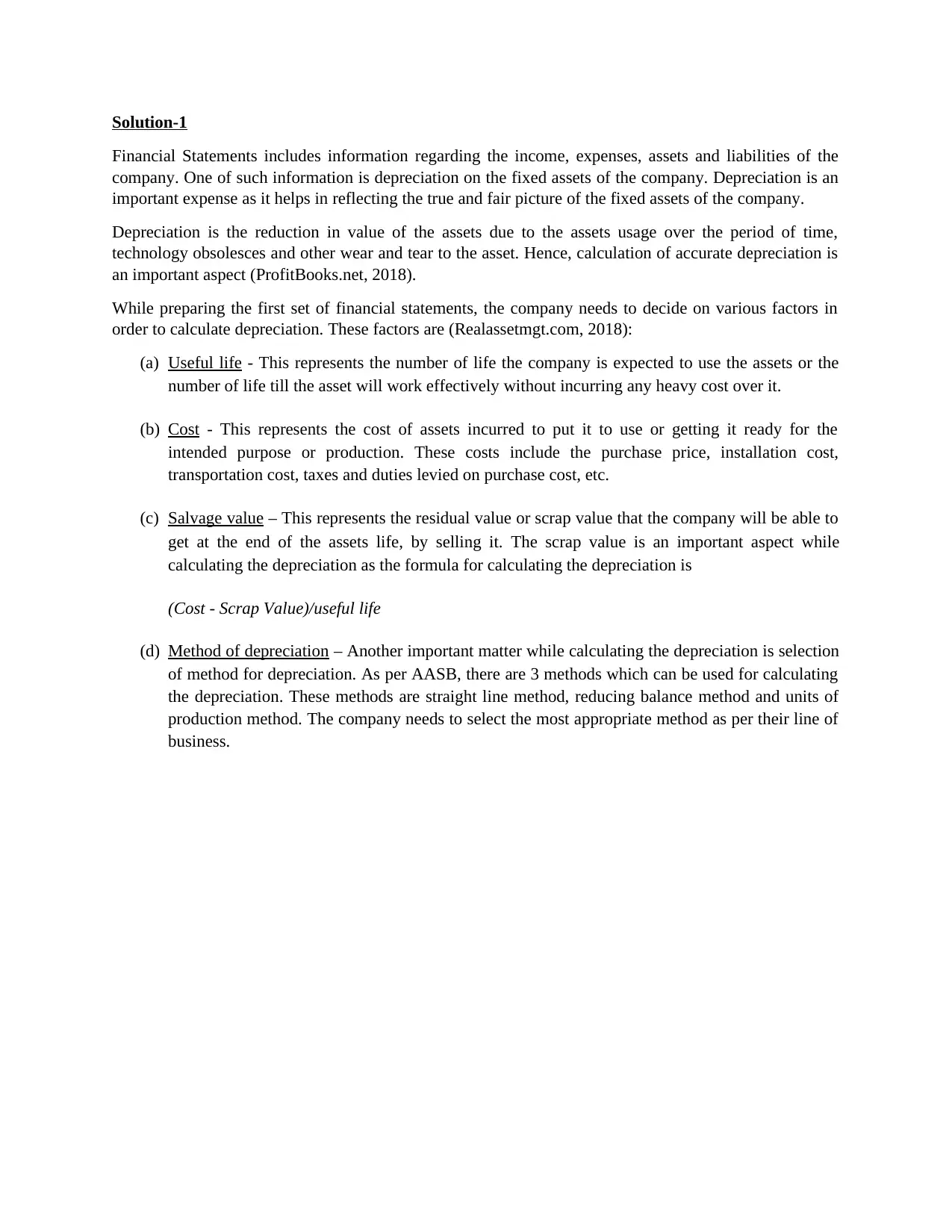
Solution-1
Financial Statements includes information regarding the income, expenses, assets and liabilities of the
company. One of such information is depreciation on the fixed assets of the company. Depreciation is an
important expense as it helps in reflecting the true and fair picture of the fixed assets of the company.
Depreciation is the reduction in value of the assets due to the assets usage over the period of time,
technology obsolesces and other wear and tear to the asset. Hence, calculation of accurate depreciation is
an important aspect (ProfitBooks.net, 2018).
While preparing the first set of financial statements, the company needs to decide on various factors in
order to calculate depreciation. These factors are (Realassetmgt.com, 2018):
(a) Useful life - This represents the number of life the company is expected to use the assets or the
number of life till the asset will work effectively without incurring any heavy cost over it.
(b) Cost - This represents the cost of assets incurred to put it to use or getting it ready for the
intended purpose or production. These costs include the purchase price, installation cost,
transportation cost, taxes and duties levied on purchase cost, etc.
(c) Salvage value – This represents the residual value or scrap value that the company will be able to
get at the end of the assets life, by selling it. The scrap value is an important aspect while
calculating the depreciation as the formula for calculating the depreciation is
(Cost - Scrap Value)/useful life
(d) Method of depreciation – Another important matter while calculating the depreciation is selection
of method for depreciation. As per AASB, there are 3 methods which can be used for calculating
the depreciation. These methods are straight line method, reducing balance method and units of
production method. The company needs to select the most appropriate method as per their line of
business.
Financial Statements includes information regarding the income, expenses, assets and liabilities of the
company. One of such information is depreciation on the fixed assets of the company. Depreciation is an
important expense as it helps in reflecting the true and fair picture of the fixed assets of the company.
Depreciation is the reduction in value of the assets due to the assets usage over the period of time,
technology obsolesces and other wear and tear to the asset. Hence, calculation of accurate depreciation is
an important aspect (ProfitBooks.net, 2018).
While preparing the first set of financial statements, the company needs to decide on various factors in
order to calculate depreciation. These factors are (Realassetmgt.com, 2018):
(a) Useful life - This represents the number of life the company is expected to use the assets or the
number of life till the asset will work effectively without incurring any heavy cost over it.
(b) Cost - This represents the cost of assets incurred to put it to use or getting it ready for the
intended purpose or production. These costs include the purchase price, installation cost,
transportation cost, taxes and duties levied on purchase cost, etc.
(c) Salvage value – This represents the residual value or scrap value that the company will be able to
get at the end of the assets life, by selling it. The scrap value is an important aspect while
calculating the depreciation as the formula for calculating the depreciation is
(Cost - Scrap Value)/useful life
(d) Method of depreciation – Another important matter while calculating the depreciation is selection
of method for depreciation. As per AASB, there are 3 methods which can be used for calculating
the depreciation. These methods are straight line method, reducing balance method and units of
production method. The company needs to select the most appropriate method as per their line of
business.
Paraphrase This Document
Need a fresh take? Get an instant paraphrase of this document with our AI Paraphraser
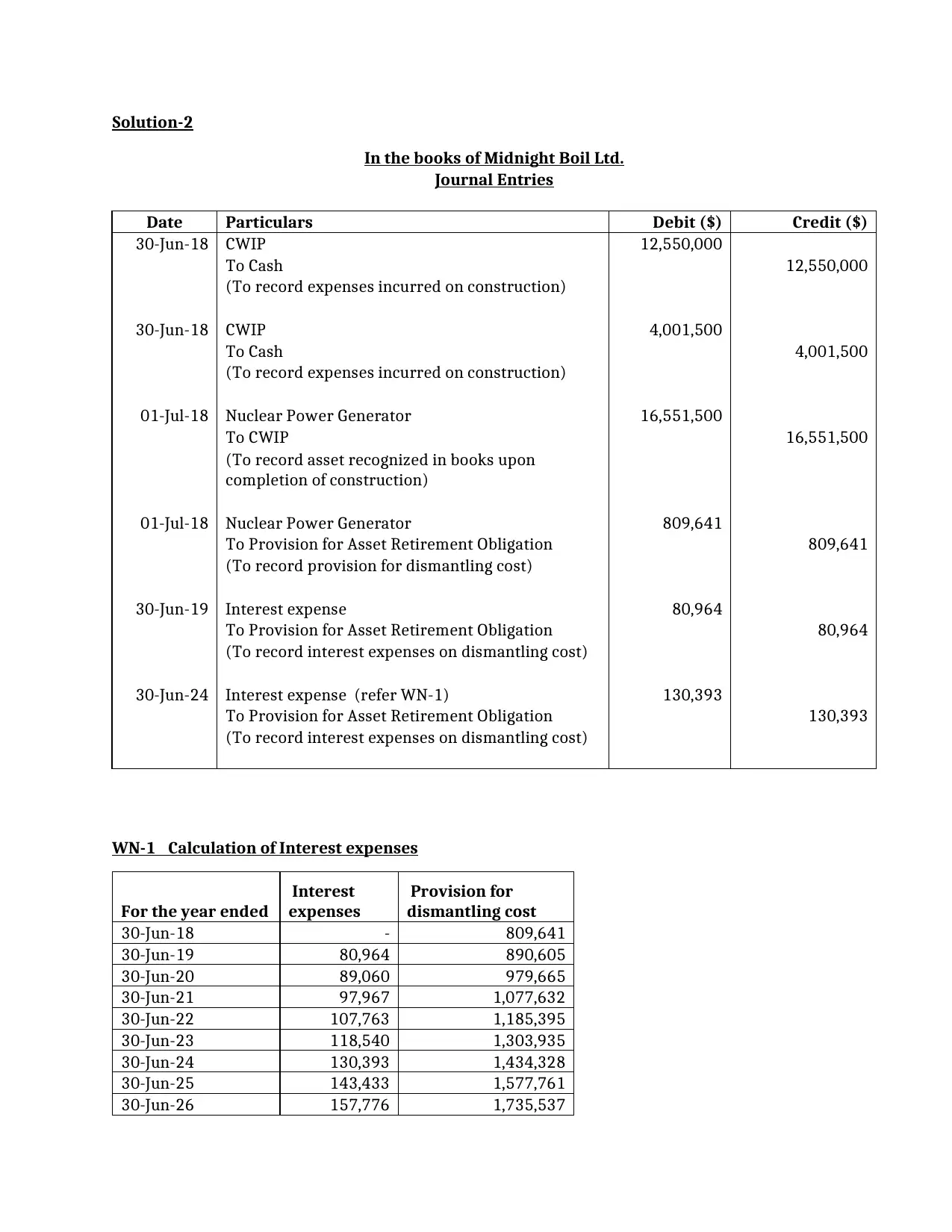
Solution-2
In the books of Midnight Boil Ltd.
Journal Entries
Date Particulars Debit ($) Credit ($)
30-Jun-18 CWIP 12,550,000
To Cash 12,550,000
(To record expenses incurred on construction)
30-Jun-18 CWIP 4,001,500
To Cash 4,001,500
(To record expenses incurred on construction)
01-Jul-18 Nuclear Power Generator 16,551,500
To CWIP 16,551,500
(To record asset recognized in books upon
completion of construction)
01-Jul-18 Nuclear Power Generator 809,641
To Provision for Asset Retirement Obligation 809,641
(To record provision for dismantling cost)
30-Jun-19 Interest expense 80,964
To Provision for Asset Retirement Obligation 80,964
(To record interest expenses on dismantling cost)
30-Jun-24 Interest expense (refer WN-1) 130,393
To Provision for Asset Retirement Obligation 130,393
(To record interest expenses on dismantling cost)
WN-1 Calculation of Interest expenses
For the year ended
Interest
expenses
Provision for
dismantling cost
30-Jun-18 - 809,641
30-Jun-19 80,964 890,605
30-Jun-20 89,060 979,665
30-Jun-21 97,967 1,077,632
30-Jun-22 107,763 1,185,395
30-Jun-23 118,540 1,303,935
30-Jun-24 130,393 1,434,328
30-Jun-25 143,433 1,577,761
30-Jun-26 157,776 1,735,537
In the books of Midnight Boil Ltd.
Journal Entries
Date Particulars Debit ($) Credit ($)
30-Jun-18 CWIP 12,550,000
To Cash 12,550,000
(To record expenses incurred on construction)
30-Jun-18 CWIP 4,001,500
To Cash 4,001,500
(To record expenses incurred on construction)
01-Jul-18 Nuclear Power Generator 16,551,500
To CWIP 16,551,500
(To record asset recognized in books upon
completion of construction)
01-Jul-18 Nuclear Power Generator 809,641
To Provision for Asset Retirement Obligation 809,641
(To record provision for dismantling cost)
30-Jun-19 Interest expense 80,964
To Provision for Asset Retirement Obligation 80,964
(To record interest expenses on dismantling cost)
30-Jun-24 Interest expense (refer WN-1) 130,393
To Provision for Asset Retirement Obligation 130,393
(To record interest expenses on dismantling cost)
WN-1 Calculation of Interest expenses
For the year ended
Interest
expenses
Provision for
dismantling cost
30-Jun-18 - 809,641
30-Jun-19 80,964 890,605
30-Jun-20 89,060 979,665
30-Jun-21 97,967 1,077,632
30-Jun-22 107,763 1,185,395
30-Jun-23 118,540 1,303,935
30-Jun-24 130,393 1,434,328
30-Jun-25 143,433 1,577,761
30-Jun-26 157,776 1,735,537

30-Jun-27 173,554 1,909,091
30-Jun-28 190,909 2,100,000
30-Jun-28 190,909 2,100,000
⊘ This is a preview!⊘
Do you want full access?
Subscribe today to unlock all pages.

Trusted by 1+ million students worldwide
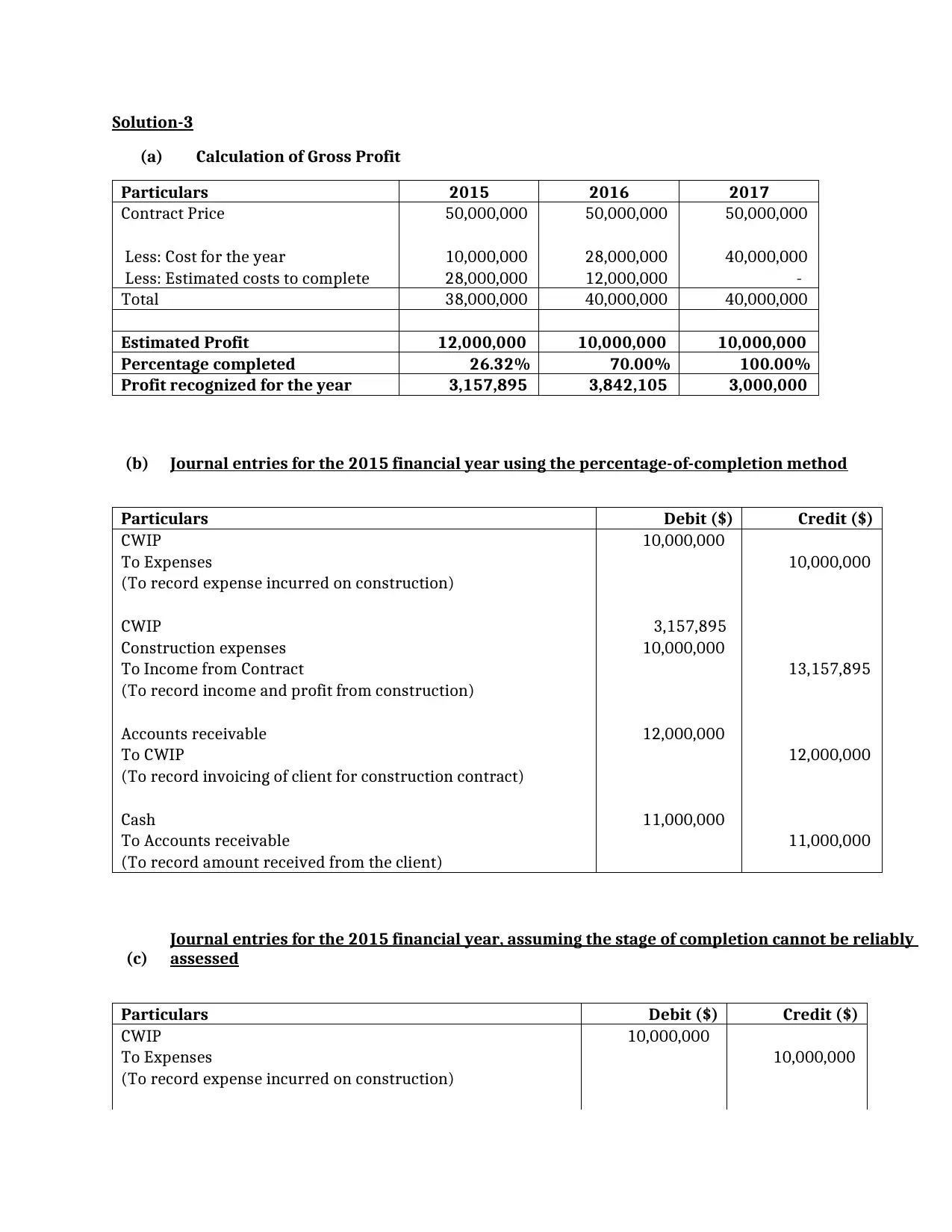
Solution-3
(a) Calculation of Gross Profit
Particulars 2015 2016 2017
Contract Price 50,000,000 50,000,000 50,000,000
Less: Cost for the year 10,000,000 28,000,000 40,000,000
Less: Estimated costs to complete 28,000,000 12,000,000 -
Total 38,000,000 40,000,000 40,000,000
Estimated Profit 12,000,000 10,000,000 10,000,000
Percentage completed 26.32% 70.00% 100.00%
Profit recognized for the year 3,157,895 3,842,105 3,000,000
(b) Journal entries for the 2015 financial year using the percentage-of-completion method
Particulars Debit ($) Credit ($)
CWIP 10,000,000
To Expenses 10,000,000
(To record expense incurred on construction)
CWIP 3,157,895
Construction expenses 10,000,000
To Income from Contract 13,157,895
(To record income and profit from construction)
Accounts receivable 12,000,000
To CWIP 12,000,000
(To record invoicing of client for construction contract)
Cash 11,000,000
To Accounts receivable 11,000,000
(To record amount received from the client)
(c)
Journal entries for the 2015 financial year, assuming the stage of completion cannot be reliably
assessed
Particulars Debit ($) Credit ($)
CWIP 10,000,000
To Expenses 10,000,000
(To record expense incurred on construction)
(a) Calculation of Gross Profit
Particulars 2015 2016 2017
Contract Price 50,000,000 50,000,000 50,000,000
Less: Cost for the year 10,000,000 28,000,000 40,000,000
Less: Estimated costs to complete 28,000,000 12,000,000 -
Total 38,000,000 40,000,000 40,000,000
Estimated Profit 12,000,000 10,000,000 10,000,000
Percentage completed 26.32% 70.00% 100.00%
Profit recognized for the year 3,157,895 3,842,105 3,000,000
(b) Journal entries for the 2015 financial year using the percentage-of-completion method
Particulars Debit ($) Credit ($)
CWIP 10,000,000
To Expenses 10,000,000
(To record expense incurred on construction)
CWIP 3,157,895
Construction expenses 10,000,000
To Income from Contract 13,157,895
(To record income and profit from construction)
Accounts receivable 12,000,000
To CWIP 12,000,000
(To record invoicing of client for construction contract)
Cash 11,000,000
To Accounts receivable 11,000,000
(To record amount received from the client)
(c)
Journal entries for the 2015 financial year, assuming the stage of completion cannot be reliably
assessed
Particulars Debit ($) Credit ($)
CWIP 10,000,000
To Expenses 10,000,000
(To record expense incurred on construction)
Paraphrase This Document
Need a fresh take? Get an instant paraphrase of this document with our AI Paraphraser
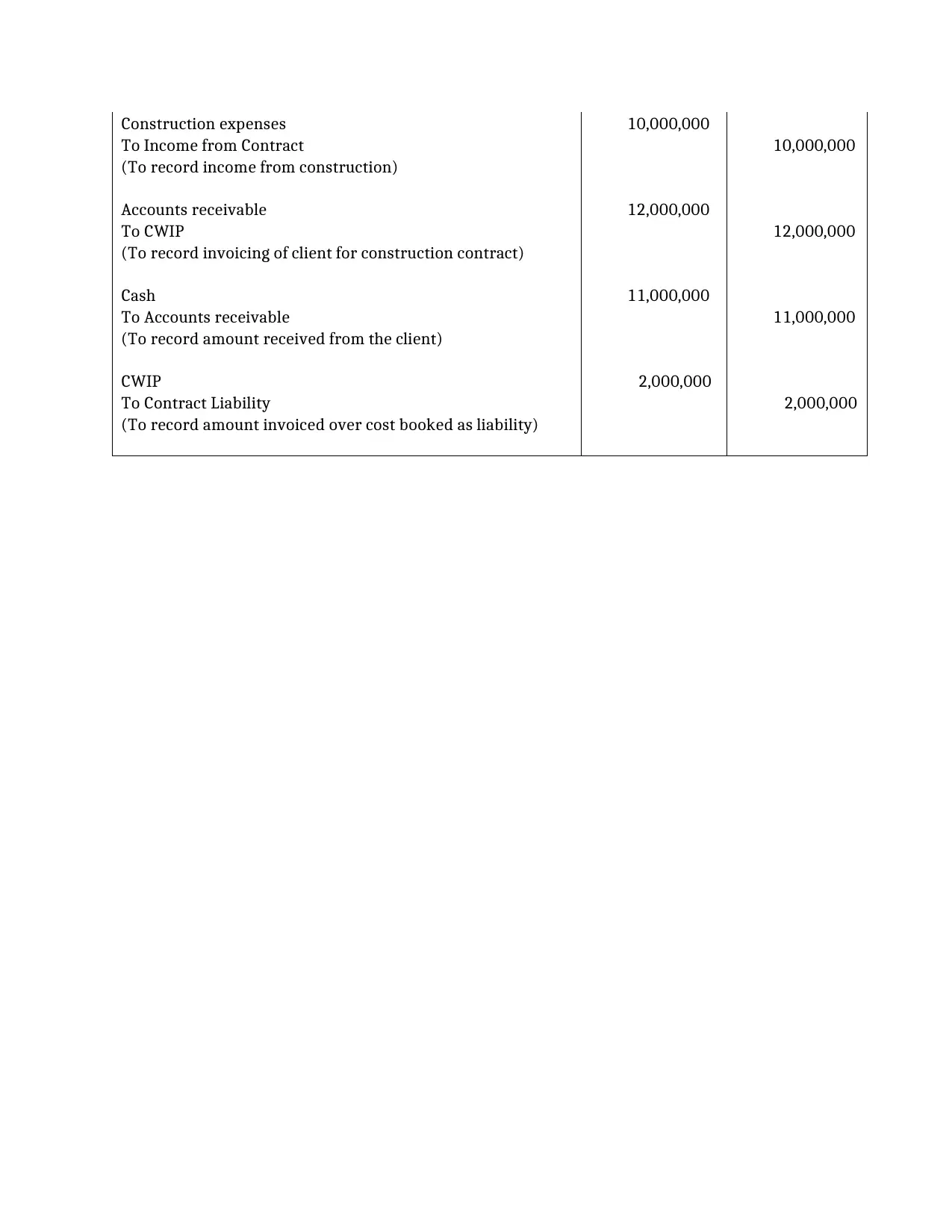
Construction expenses 10,000,000
To Income from Contract 10,000,000
(To record income from construction)
Accounts receivable 12,000,000
To CWIP 12,000,000
(To record invoicing of client for construction contract)
Cash 11,000,000
To Accounts receivable 11,000,000
(To record amount received from the client)
CWIP 2,000,000
To Contract Liability 2,000,000
(To record amount invoiced over cost booked as liability)
To Income from Contract 10,000,000
(To record income from construction)
Accounts receivable 12,000,000
To CWIP 12,000,000
(To record invoicing of client for construction contract)
Cash 11,000,000
To Accounts receivable 11,000,000
(To record amount received from the client)
CWIP 2,000,000
To Contract Liability 2,000,000
(To record amount invoiced over cost booked as liability)
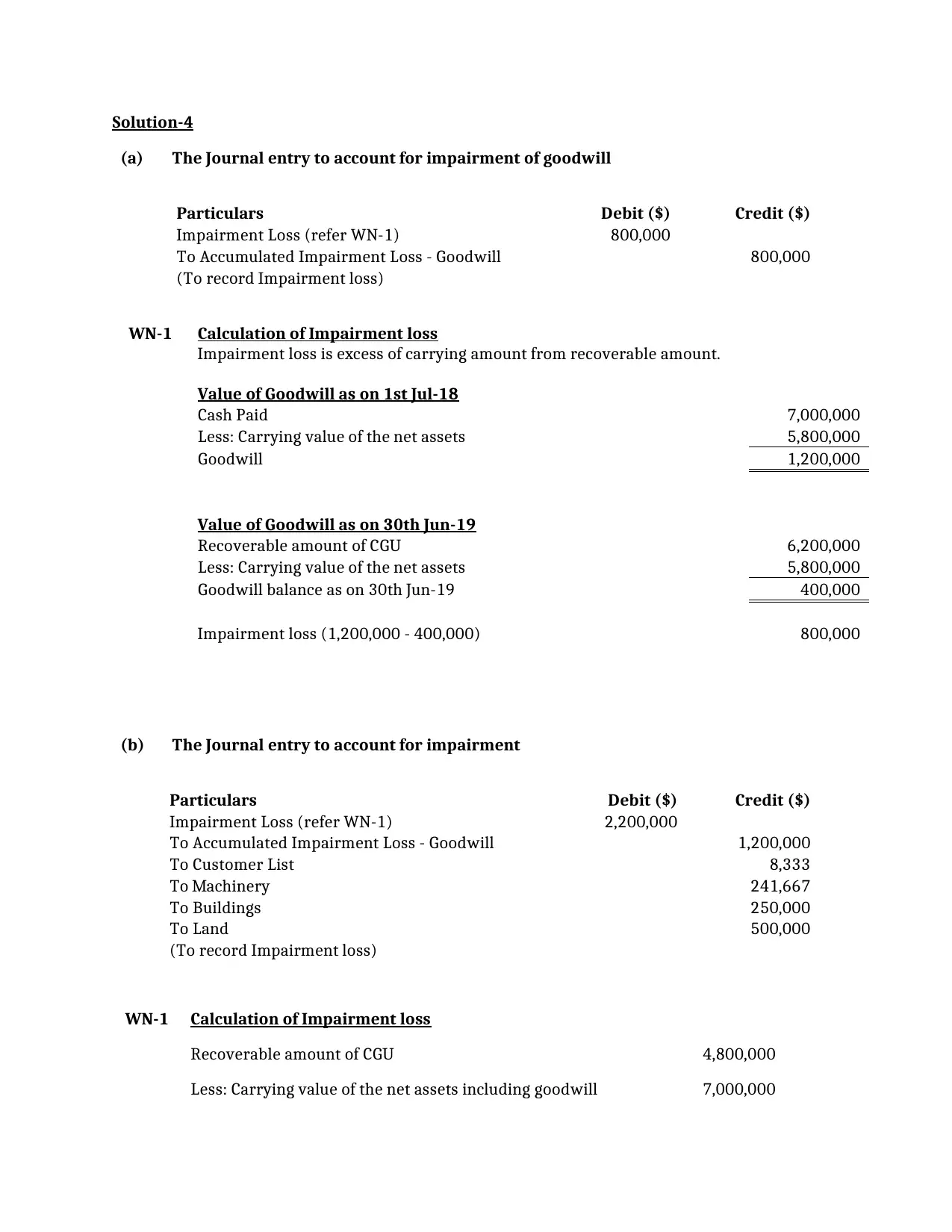
Solution-4
(a) The Journal entry to account for impairment of goodwill
Particulars Debit ($) Credit ($)
Impairment Loss (refer WN-1) 800,000
To Accumulated Impairment Loss - Goodwill 800,000
(To record Impairment loss)
WN-1 Calculation of Impairment loss
Impairment loss is excess of carrying amount from recoverable amount.
Value of Goodwill as on 1st Jul-18
Cash Paid 7,000,000
Less: Carrying value of the net assets 5,800,000
Goodwill 1,200,000
Value of Goodwill as on 30th Jun-19
Recoverable amount of CGU 6,200,000
Less: Carrying value of the net assets 5,800,000
Goodwill balance as on 30th Jun-19 400,000
Impairment loss (1,200,000 - 400,000) 800,000
(b) The Journal entry to account for impairment
Particulars Debit ($) Credit ($)
Impairment Loss (refer WN-1) 2,200,000
To Accumulated Impairment Loss - Goodwill 1,200,000
To Customer List 8,333
To Machinery 241,667
To Buildings 250,000
To Land 500,000
(To record Impairment loss)
WN-1 Calculation of Impairment loss
Recoverable amount of CGU 4,800,000
Less: Carrying value of the net assets including goodwill 7,000,000
(a) The Journal entry to account for impairment of goodwill
Particulars Debit ($) Credit ($)
Impairment Loss (refer WN-1) 800,000
To Accumulated Impairment Loss - Goodwill 800,000
(To record Impairment loss)
WN-1 Calculation of Impairment loss
Impairment loss is excess of carrying amount from recoverable amount.
Value of Goodwill as on 1st Jul-18
Cash Paid 7,000,000
Less: Carrying value of the net assets 5,800,000
Goodwill 1,200,000
Value of Goodwill as on 30th Jun-19
Recoverable amount of CGU 6,200,000
Less: Carrying value of the net assets 5,800,000
Goodwill balance as on 30th Jun-19 400,000
Impairment loss (1,200,000 - 400,000) 800,000
(b) The Journal entry to account for impairment
Particulars Debit ($) Credit ($)
Impairment Loss (refer WN-1) 2,200,000
To Accumulated Impairment Loss - Goodwill 1,200,000
To Customer List 8,333
To Machinery 241,667
To Buildings 250,000
To Land 500,000
(To record Impairment loss)
WN-1 Calculation of Impairment loss
Recoverable amount of CGU 4,800,000
Less: Carrying value of the net assets including goodwill 7,000,000
⊘ This is a preview!⊘
Do you want full access?
Subscribe today to unlock all pages.

Trusted by 1+ million students worldwide
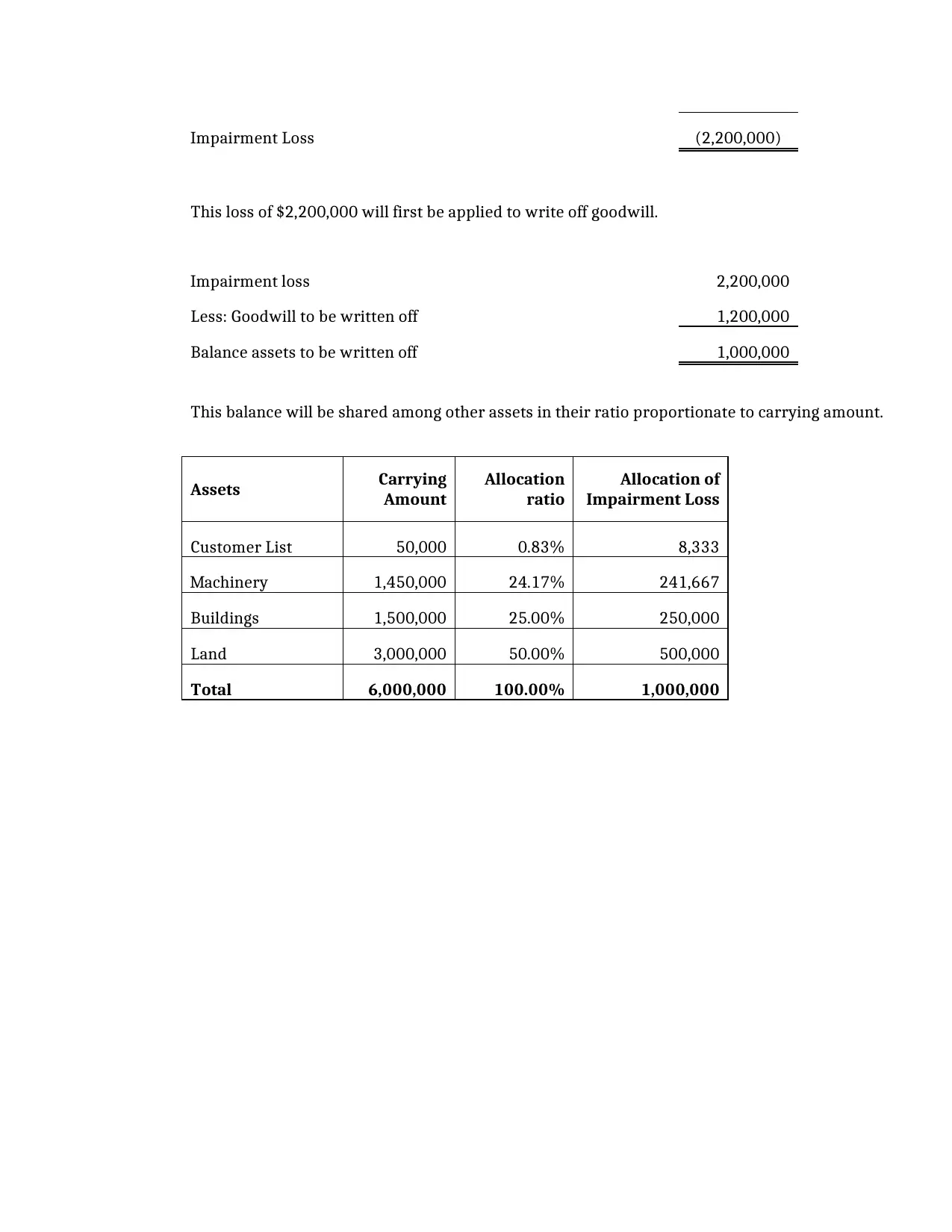
Impairment Loss (2,200,000)
This loss of $2,200,000 will first be applied to write off goodwill.
Impairment loss 2,200,000
Less: Goodwill to be written off 1,200,000
Balance assets to be written off 1,000,000
This balance will be shared among other assets in their ratio proportionate to carrying amount.
Assets Carrying
Amount
Allocation
ratio
Allocation of
Impairment Loss
Customer List 50,000 0.83% 8,333
Machinery 1,450,000 24.17% 241,667
Buildings 1,500,000 25.00% 250,000
Land 3,000,000 50.00% 500,000
Total 6,000,000 100.00% 1,000,000
This loss of $2,200,000 will first be applied to write off goodwill.
Impairment loss 2,200,000
Less: Goodwill to be written off 1,200,000
Balance assets to be written off 1,000,000
This balance will be shared among other assets in their ratio proportionate to carrying amount.
Assets Carrying
Amount
Allocation
ratio
Allocation of
Impairment Loss
Customer List 50,000 0.83% 8,333
Machinery 1,450,000 24.17% 241,667
Buildings 1,500,000 25.00% 250,000
Land 3,000,000 50.00% 500,000
Total 6,000,000 100.00% 1,000,000
Paraphrase This Document
Need a fresh take? Get an instant paraphrase of this document with our AI Paraphraser
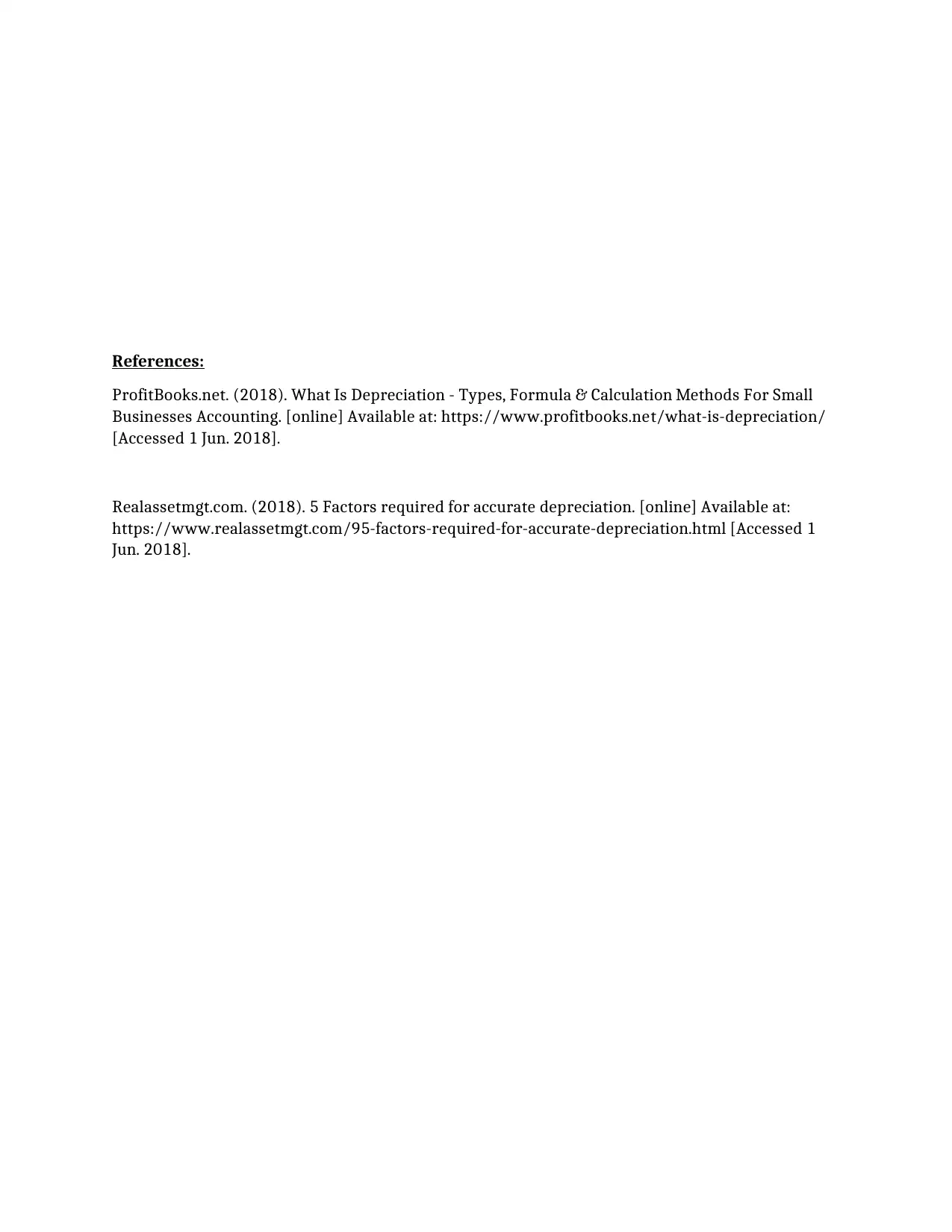
References:
ProfitBooks.net. (2018). What Is Depreciation - Types, Formula & Calculation Methods For Small
Businesses Accounting. [online] Available at: https://www.profitbooks.net/what-is-depreciation/
[Accessed 1 Jun. 2018].
Realassetmgt.com. (2018). 5 Factors required for accurate depreciation. [online] Available at:
https://www.realassetmgt.com/95-factors-required-for-accurate-depreciation.html [Accessed 1
Jun. 2018].
ProfitBooks.net. (2018). What Is Depreciation - Types, Formula & Calculation Methods For Small
Businesses Accounting. [online] Available at: https://www.profitbooks.net/what-is-depreciation/
[Accessed 1 Jun. 2018].
Realassetmgt.com. (2018). 5 Factors required for accurate depreciation. [online] Available at:
https://www.realassetmgt.com/95-factors-required-for-accurate-depreciation.html [Accessed 1
Jun. 2018].
1 out of 8
Related Documents
Your All-in-One AI-Powered Toolkit for Academic Success.
+13062052269
info@desklib.com
Available 24*7 on WhatsApp / Email
![[object Object]](/_next/static/media/star-bottom.7253800d.svg)
Unlock your academic potential
Copyright © 2020–2026 A2Z Services. All Rights Reserved. Developed and managed by ZUCOL.





